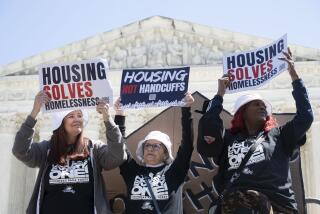Possible Homeless Centers Identified
Los Angeles County officials are trying to determine whether any of 14 small drop-in centers for homeless people can be converted to the five regional facilities being established as the county attempts to move services for transients out of downtown.
The facilities are in communities across Los Angeles County, including Pasadena, Long Beach, North Hollywood, El Monte, Santa Monica, Venice, West Covina and Glendale. While the use of existing centers might be more politically palatable to local communities, officials acknowledged that the facilities would have to be dramatically expanded to house both shelter beds and a variety of social services.
“We know we are going to deal with the NIMBYism,” said Orlando Ward, director of public affairs for the Midnight Mission and a member of the advisory panel that drafted the county plan. “The poison pill is the community input process. Especially when a neighborhood is not very excited about the whole plan, let alone stabilization centers.”
Most of the facilities now being considered are modest in size, providing drop-in services Monday through Friday, with no overnight stays. They are typically run by nonprofit groups but supported in part by federal funds.
By contrast, the regional stabilization facilities -- the centerpiece of a $100-million homeless plan that the county Board of Supervisors approved Tuesday -- would be much larger. Each center would have 30 to 40 shelter beds for temporary housing, on-site nurses, social workers and drug treatment specialists, and an annual budget of about $1.43 million.
In some communities, the idea is already looking like a tough sell.
West Covina Mayor Steve Herfert vowed that his city would fight efforts to create a regional homeless center at a site on Glendora Avenue.
“That is right in the middle of town. We’ve been revitalizing the area,” Herfert said Wednesday. “It is a tiny center. There will be a lot of opposition.... I don’t know why they are looking at our city.”
County officials envision the centers as one-stop, full-service destinations for the homeless, where they could go after leaving County Jail or hospitals, or be taken to by local law enforcement as an alternative to jail for minor offenses. The centers would be open 24 hours a day, seven days a week.
Under the county plan, people would remain at the center no more than 30 days and receive counseling about where to go for temporary or permanent housing, substance abuse treatment, mental health care and public benefit programs.
County officials plan to review the 14 sites over the next few months to determine which ones would be suitable for conversion into a regional center. A big question is whether the facilities -- some in office parks, others in commercial zones, some near homes -- could be expanded.
While several of the sites are downtown, officials said only one would be selected, and it would probably focus on helping homeless inmates once they are released from County Jail. Each of the five supervisorial districts would have one regional center.
In deciding to establish the five centers, the county reversed its long-standing policy of concentrating homeless services in downtown’s skid row. It is part of a major push by city and state officials to clean up skid row, which has the largest concentration of homeless people on the West Coast. The effort comes after The Times published a series of stories exploring the area’s problems.
Opposition to the county’s plan, however, extends beyond West Covina -- and even beyond the neighborhoods where the facilities are located. Susan Polifronio, a longtime community activist in Hollywood, said her area already has too many homeless facilities and that it doesn’t make sense to simply move more of skid row’s problems into Hollywood.
“I’d be concerned about any move to bring more homeless into the area,” she said.
But other community leaders were guardedly supportive.
“We will all take our fair share of responsibility,” said Los Angeles Councilman Bill Rosendahl, whose district includes the potential Venice site. “With Santa Monica and Los Angeles, we do have a substantial number of homeless.... It would be great if we could locate one that would work for the Westside.”
In approving the plan, the Board of Supervisors vowed that the five centers would be built “in cooperation with” local government but expressly rejected a proposal by Supervisor Don Knabe to give cities veto power over the projects.
Some officials involved in the county plan remain optimistic that they can find five sites acceptable to the surrounding communities.
“We are not talking about building a new building,” said Joel Roberts, chairman of the county committee and the chief executive of People Assisting the Homeless. “Personally, I don’t think it’s as hard as people say it is.”
If the access centers cannot be expanded, county officials would then look at county properties that are closed or underutilized -- also partly to avoid angering local communities loath to place homeless services in their area. One such facility is the county’s Department of Public Social Services office in Hawthorne, where much of the building, the former Hawthorne Mall, is empty.
Still, West Covina’s Herfert is skeptical.
“I don’t think any city is going to want it,” he said.
More to Read
Sign up for Essential California
The most important California stories and recommendations in your inbox every morning.
You may occasionally receive promotional content from the Los Angeles Times.











